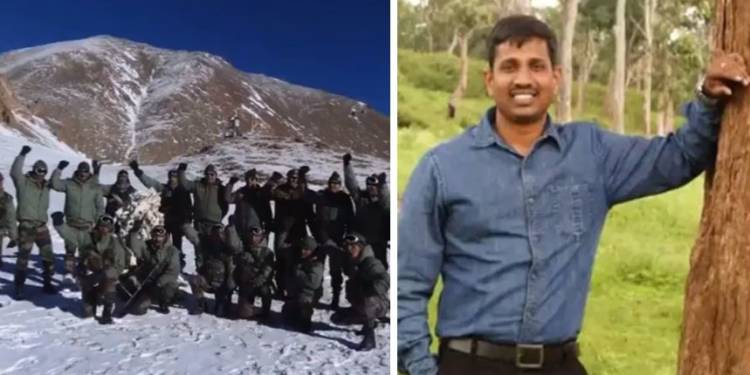It is a week since the Galwan Valley area of Eastern Ladakh witnessed a violent face-off between the Indian Army and People’s Liberation Army (PLA) troops that resulted in unprecedented bloodshed near the Line of Actual Control (LAC)- the effective Sino-India border.
In lack of clarity, the reports about the face-off have been filled with contradictions and gaps in the entire chain of events. But we now have a detailed account of what actually conspired on the fateful day. According to ANI, the face-off was triggered by a Chinese Observation Post at Patrolling Point-14 (PP-14) in the Galwan Valley area. The situation would soon escalate into a violent clash as a young Indian Army team decided to go across the LAC.
The June 15 incident happened in the backdrop of a disengagement process, ten days after a Corps Commander-level meeting between the two sides. It was in accordance with this disengagement process that the Chinese dismantled this Observation Post, but the Post came up again overnight on June 14.
The 16 Bihar Infantry Battalion led by late Colonel Santosh Babu was required to ensure that the Chinese removed this Post. Writing for India Today, Shiv Aroor has stated that the Commanding Officer himself led a team that reached the Chinese Observation Post. Remember that though the atmosphere was tense due to the ongoing military stand-off but there were no feelings of animosity or high tempers as of now.
The People’s Liberation Army (PLA) had however already planned a military confrontation, and when the Indian Army Patrol team reached the spot with the aim of inquiring the reason for re-establishment of the Chinese Observation Post, they were met with ‘new’ faces.
The PLA had sent a new set of troops, freshly diverted from a PLA exercise in China-occupied Tibet in the latter half of May. The first confrontation, most innocuous of the three tussles, happened here. The ‘new’ PLA troops were immediately belligerent as against a professional Indian Army team led by a calm Colonel.
The Chinese soldiers pushed Colonel Santosh Babu and hurled Chinese expletives at him, which paved the way for an hours-long clash. The Indian Army team became furious at their Commanding Officer being disrespected by the Chinese- after all Indian soldiers have utmost affection for their Commanding Officers. To see your Commanding Officer getting disrespected is no less than seeing your parents getting abused.
So, the 16 Bihar infantry troops pounced upon the Chinese and engaged in fist-fights that lasted for half an hour. There were injuries on both sides, but the Indian side prevailed and the Observation Post was reduced to ashes. But the PLA had already invited the wrath of the Indian Army by assaulting Colonel Santosh Babu.
Alarmed by the re-establishment of the Chinese Post that was now dismantled and the ‘new’ faces on the Chinese side as opposed to the friendly faces in the Galwan Valley region, a decision was taken to cross into the Chinese side. It is also possible that some unusual, suspicious movement and troop buildup was detected on the Chinese side.
Anyway, the second phase of the violent face-off would happen when the Indian team crossed into the Chinese side. It was during this face-off that most of the casualties happened.
India Today TV quotes an Indian Army officer deployed near the Shyok-Galwan confluence as saying, “The boys were angry and aggressive. You can imagine how much they wanted to teach a lesson to the aggressors.”
Colonel Babu’s worries about the sudden change in Chinese attitude came true, as the ‘new’ type of PLA troops were waiting in the positions on the banks of the Galwan River and also in positions up on a ridge.
The Chinese troops started targeting the Indian soldiers with heavy stones. One of these stones landing on the Indian troops from the ridge above them struck the Commanding Officer- Colonel Babu, who fell into the narrow Galwan river. Tempers ran high after this incident.
For the next 45 minutes, troops from both sides engaged in a bitter, violent face-off during which the bodies piled up. The Bihar Regiment battalion was heavily outnumbered- a total of 100 Indian Army troops as against 300-350 PLA troops on the location.
But as Mark Twain had said, “It’s not the size of the dog in the fight, it’s the size of the fight in the dog,” the Bihar Regiment soldiers were ferocious and they attacked the Chinese troops against all odds.
The third phase of the face-off happened after 11 PM in the night when the Indian Army was bolstered by the Ghatak Platoons from both the 16 Bihar as well as 3 Punjab Regiment.
The Ghatak Platoons in the Indian Army battalions are ‘shock troops’ who excel in close-quarter battles and spearhead assaults ahead of the battalion. The Indian Army troops went deeper into the Chinese side in order to ensure that aggressive PLA troops are prevented from coming close to the LAC.
The fight was spread over a large area across different pockets across the LAC, as opposed to a mob battle at a particular point. Casualties happened during hand-to-hand combat and use of other melee weapons, when men from both sides fell into the narrow Galwan river. Many got injured as they plunged onto heavy rocks that are common in the location of the violent face-off.
Reports suggest that Indian soldiers entered a rage that China had not foreseen, and they started fighting with bare hands and snapped necks of PLA soldiers. The iron rods and spiked nail bats used by the Chinese soon fell into the hands of the Indians. Heavy casualties have been inflicted on the Chinese, and 16 bodies were returned to them by the time the face-off ended. China had 16 initial casualties as compared to three initial casualties on the Indian side. One can only imagine the number of PLA troops who would have died, and also understand why China doesn’t want to reveal the numbers.
India gave China a bloody nose to the Chinese on the Chinese side, and this only adds to the glory of the Bihar Regiment which had also given a bloody nose to the Pakistan Army in the Summers of 1999, exactly 21 years ago. The highly decorated Regiment of the Indian Army is around seven decades old, and has participated in many wars- the 1948 war, the 1965 war, the 1971 war and the 1999 Kargil war. It has delivered every single time.
https://twitter.com/NorthernComd_IA/status/1274375321848934402
The detailed account of the Galwan bloodshed is finally revealed, and the real report exposes how Indians whopped the hell out of the Chinese PLA.
































As an American, I am SO PROUD of the largest Democracy INDIA in punishing the Communists for their mutant behavior.
The Chinese are ten feet tall when it comes to punishing peaceful Tibetan Monks, but they scatter like dogs when faced with tough combat hardened Indian troops. Congratulations! Namaste! God bless.
Of course this entire narrative is a fopped up
school boy puff which never really happened,
clue is suggestion melee weapons used,
that’s not how one kills these days.
Poppycock and balderall.